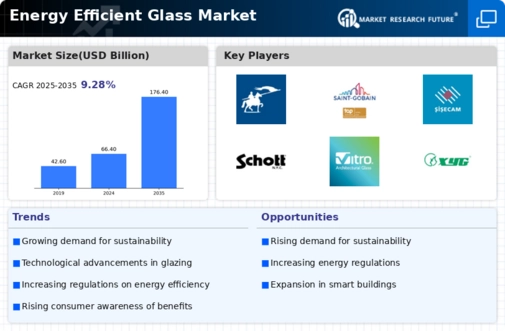Market Growth Projections
The Global Energy Efficient Glass Market Industry is projected to experience substantial growth over the coming years. With a market size anticipated to reach 66.4 USD Billion in 2024 and further expand to 176.4 USD Billion by 2035, the industry is poised for a robust trajectory. The compound annual growth rate of 9.28% from 2025 to 2035 indicates a strong demand for energy-efficient solutions across various sectors. This growth is driven by factors such as technological advancements, regulatory support, and increasing consumer awareness, suggesting a promising future for energy-efficient glass in the global market.
Rising Demand for Energy Efficiency
The Global Energy Efficient Glass Market Industry is experiencing a surge in demand driven by the increasing emphasis on energy efficiency in buildings. Governments worldwide are implementing stringent regulations aimed at reducing energy consumption, which propels the adoption of energy-efficient glass solutions. For instance, energy-efficient glass can reduce heating and cooling costs by up to 30 percent, making it an attractive option for both residential and commercial properties. The market is projected to reach 66.4 USD Billion in 2024, reflecting a growing awareness of sustainability and energy conservation among consumers and businesses alike.
Government Incentives and Regulations
Government initiatives play a crucial role in shaping the Global Energy Efficient Glass Market Industry. Many countries are offering financial incentives, tax rebates, and subsidies to encourage the use of energy-efficient materials in construction. For example, the implementation of energy codes and standards has made it mandatory for new buildings to incorporate energy-efficient glass. This regulatory environment not only fosters market growth but also aligns with global sustainability goals. As the market evolves, these incentives are likely to drive further adoption, contributing to an anticipated market size of 176.4 USD Billion by 2035.
Expansion of Green Building Initiatives
The expansion of green building initiatives is a pivotal driver for the Global Energy Efficient Glass Market Industry. As urbanization accelerates, there is a growing focus on sustainable construction practices that minimize environmental impact. Energy-efficient glass is a key component of green building certifications such as LEED and BREEAM, which are gaining traction globally. This trend not only enhances the aesthetic appeal of buildings but also contributes to energy savings and improved occupant comfort. The increasing number of green building projects is likely to further propel the market, aligning with global efforts to create more sustainable urban environments.
Growing Awareness of Environmental Impact
There is a notable increase in consumer awareness regarding the environmental impact of construction materials, which is positively affecting the Global Energy Efficient Glass Market Industry. As individuals and organizations become more conscious of their carbon footprints, the demand for sustainable building materials, including energy-efficient glass, is rising. This trend is evident in various sectors, including residential, commercial, and industrial, where energy-efficient glass is being prioritized for its ability to reduce greenhouse gas emissions. Consequently, this heightened awareness is expected to sustain market growth and innovation in energy-efficient solutions.
Technological Advancements in Glass Manufacturing
Innovations in glass manufacturing technologies are significantly influencing the Global Energy Efficient Glass Market Industry. Advances such as low-emissivity coatings and triple glazing are enhancing the thermal performance of glass, thereby improving energy efficiency. These technologies not only provide better insulation but also allow for greater natural light penetration, which is increasingly favored in modern architectural designs. As a result, the market is expected to witness a compound annual growth rate of 9.28% from 2025 to 2035, indicating a robust shift towards more advanced glass solutions that meet contemporary energy standards.























Leave a Comment